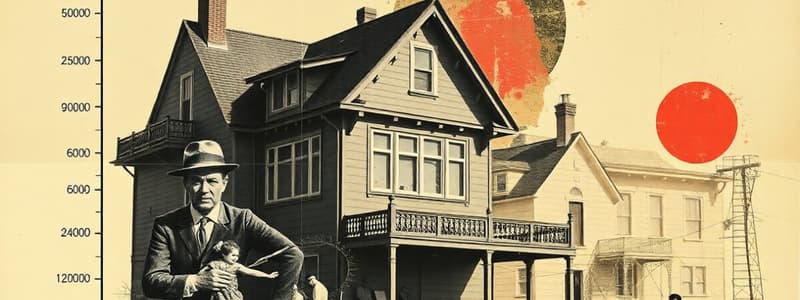Podcast
Questions and Answers
What absorption rate is typically associated with a seller's market?
What absorption rate is typically associated with a seller's market?
- Exactly 15%
- Above 20% (correct)
- Below 5%
- Between 5% and 15%
In a buyer's market, how does the absorption rate typically behave?
In a buyer's market, how does the absorption rate typically behave?
- It tends to be above 25%
- It remains constant
- It equals the sales rate
- It is lower due to high supply (correct)
Using the absorption rate formula, what would an absorption rate of 5% imply for property sales?
Using the absorption rate formula, what would an absorption rate of 5% imply for property sales?
- Properties are abundant but not selling
- The market is favorable for buyers (correct)
- Properties are sold at a high speed
- The market has balanced supply and demand
If a market has 200 properties listed and 50 are sold per month, what is the absorption rate?
If a market has 200 properties listed and 50 are sold per month, what is the absorption rate?
What does a high absorption rate signify for a real estate seller?
What does a high absorption rate signify for a real estate seller?
How long would it take to sell all properties if the total number of listed properties is 30,000 and the average monthly sales are 10,000?
How long would it take to sell all properties if the total number of listed properties is 30,000 and the average monthly sales are 10,000?
Which of the following statements best describes a buyer’s market?
Which of the following statements best describes a buyer’s market?
In a seller’s market, what effect does a low absorption rate have on buyers?
In a seller’s market, what effect does a low absorption rate have on buyers?
What absorption rate would indicate a balanced market?
What absorption rate would indicate a balanced market?
What was the absorption rate for West Side Vancouver in July 2017?
What was the absorption rate for West Side Vancouver in July 2017?
What is the absorption rate primarily used to indicate in real estate markets?
What is the absorption rate primarily used to indicate in real estate markets?
If a city has 1,000 homes for sale and 100 are sold each month, how many months until the supply is exhausted?
If a city has 1,000 homes for sale and 100 are sold each month, how many months until the supply is exhausted?
Which absorption rate percentage typically indicates a seller's market?
Which absorption rate percentage typically indicates a seller's market?
What might a high absorption rate suggest to homeowners looking to sell their property?
What might a high absorption rate suggest to homeowners looking to sell their property?
What action might real estate agents take during periods with low absorption rates?
What action might real estate agents take during periods with low absorption rates?
How does the absorption rate impact property valuation during a low demand period?
How does the absorption rate impact property valuation during a low demand period?
In a situation where the absorption rate is below 15%, what type of market is typically present?
In a situation where the absorption rate is below 15%, what type of market is typically present?
What would a high absorption rate indicate to developers?
What would a high absorption rate indicate to developers?
Flashcards are hidden until you start studying
Study Notes
Absorption Rate
- The absorption rate measures how quickly homes are selling in a specific real estate market.
- It's calculated by dividing the average number of homes sold each month by the total number of homes available for sale.
- A higher absorption rate indicates a seller's market, where homes sell quickly, and the supply of available homes shrinks rapidly.
- A lower absorption rate indicates a buyer's market, where homes sell slowly, and buyers have more bargaining power.
- Traditionally, an absorption rate above 20% signals a seller's market, while a rate below 15% suggests a buyer's market.
- The absorption rate doesn't account for new homes added to the market.
Real Estate Applications
- Real estate professionals use the absorption rate to price homes.
- In low absorption rate markets, agents may need to lower listing prices to attract buyers.
- In high absorption rate markets, agents can charge higher prices due to strong demand.
- The absorption rate helps developers decide whether to build new homes, responding to high demand in seller's markets.
- Appraisers factor in the absorption rate when determining property values, reducing valuations during periods of low absorption.
Buyer's Market
- A buyer's market is characterized by a surplus of homes available for sale compared to buyers.
- This favors buyers because they have more choices and potential for negotiating lower prices.
- The absorption rate in a buyer's market is low, indicating slow sales.
Seller's Market
- A seller's market is characterized by a shortage of homes available for sale compared to buyers.
- This favors sellers because they have more leverage to negotiate higher prices.
- The absorption rate in a seller's market is high, indicating fast sales.
Example Calculation
- If a city has 1,000 homes for sale and 100 are sold each month, the absorption rate is 10% (100/1,000).
- This means it would take 10 months (1,000 / 100) for all the available homes to be sold.
Importance
- The absorption rate guides both buyers and sellers on market conditions.
- It helps assess how long it will take to sell existing inventory in a specific market.
- It reflects the balance between supply and demand in real estate and how it affects pricing power.
Studying That Suits You
Use AI to generate personalized quizzes and flashcards to suit your learning preferences.




